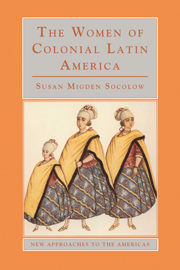Book contents
- Frontmatter
- Contents
- List of Illustrations
- Acknowledgments
- Introduction: Why Women?
- 1 Iberian Women in the Old World and the New
- 2 Before Columbus: Women in Indigenous America and Africa
- 3 Conquest and Colonization
- 4 The Arrival of Iberian Women
- 5 Women, Marriage, and Family
- 6 Elite Women
- 7 The Brides of Christ and Other Religious Women
- 8 Women and Work
- 9 Women and Slavery
- 10 Women and Social Deviance: Crime, Witchcraft, and Rebellion
- 11 Women and Enlightenment Reform
- Conclusion
- Documents
- Suggested Further Reading
- Index
- Plate section
2 - Before Columbus: Women in Indigenous America and Africa
Published online by Cambridge University Press: 05 June 2012
- Frontmatter
- Contents
- List of Illustrations
- Acknowledgments
- Introduction: Why Women?
- 1 Iberian Women in the Old World and the New
- 2 Before Columbus: Women in Indigenous America and Africa
- 3 Conquest and Colonization
- 4 The Arrival of Iberian Women
- 5 Women, Marriage, and Family
- 6 Elite Women
- 7 The Brides of Christ and Other Religious Women
- 8 Women and Work
- 9 Women and Slavery
- 10 Women and Social Deviance: Crime, Witchcraft, and Rebellion
- 11 Women and Enlightenment Reform
- Conclusion
- Documents
- Suggested Further Reading
- Index
- Plate section
Summary
Aztec birth ritual: “Thou wilt be in the heart of the home, thou wilt go nowhere, thou wilt nowhere become a wanderer, thou becomest the banked fire, the hearth stones. Here our lord planteth thee, burieth thee. And thou wilt become fatigued, thou wilt become tired; thou art to provide water, to grind maize, to drudge; thou art of sweat by the ashes, by the hearth.”
Andean burial ritual: “The women have their spindles and skeins of spun cottons, the men their tacllas or hoes to work the fields, or the weapons they used in war.”
[Among the Bijago] the women build the houses and work in the fields, and they fish and gather shellfish, doing all that men do elsewhere.
The Iberian experience in the New World put the Spanish and Portuguese into immediate and intimate contact with peoples from two very different cultures: the indigenous inhabitants of America and Africans transported to the region as slaves. Although historians have examined the dynamics and results of the meeting of these three groups, few have considered the role of women in the Americas or Africa before these peoples were subjected to Iberian control.
Although Indians had inhabited America for thousands of years before the arrival of the Spaniards and Portuguese, we know very little about women in those earlier Indian societies.
- Type
- Chapter
- Information
- The Women of Colonial Latin America , pp. 16 - 31Publisher: Cambridge University PressPrint publication year: 2000

